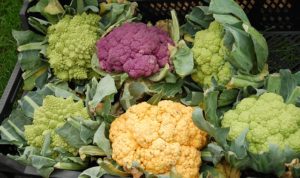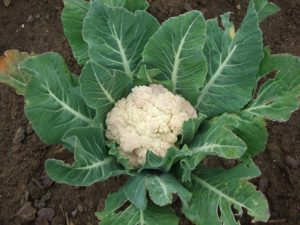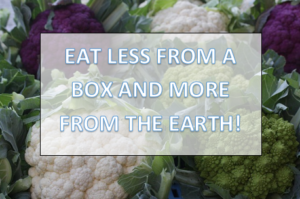 Some may think of it as a “boring” vegetable.
Some may think of it as a “boring” vegetable.
It’s extremely common, colorless, and seems to go hand-in-hand with broccoli. It’s often served plain or boiled…or maybe you think the only way you like cauliflower is loaded with a thick, creamy cheese sauce?!
Brace yourself! Cauliflower’s reputation has been changing and we want to turn the “boring vegetable” perception upside down and help you enjoy the incredible nutrition — and taste — cauliflower has to offer.
Which is why it’s our September Superfood of the Month!
What is cauliflower all about?
While cauliflower is available year-round, its peak season is late summer and fall. Much of the world’s cauliflower is produced in China and India; however, many local farmers produce some fantastic varieties. There are actually over 100 varieties of cauliflower with different color, size, shape and taste.
Have you seen purple cauliflower?
 White is by far the most popular color, but you can often find green, orange (which has a sweet and mild taste) and purple (mild taste and slightly nutty). No, they have not been injected with food coloring!
White is by far the most popular color, but you can often find green, orange (which has a sweet and mild taste) and purple (mild taste and slightly nutty). No, they have not been injected with food coloring!
Purple cauliflower gets its color from the antioxidant anthocyanin, which is also found in red cabbage and red wine. Orange cauliflower produces its color from a breeding approach that allows it to hold more beta carotene. Most likely, you will find these varieties at local farmers’ markets, and you can enjoy them (cooked or raw) the same as white cauliflower. So, go ahead and enjoy the rainbow!
Why is most cauliflower white?
 It’s because the large, course leaves keep the florets hidden from the sun, preventing the color-producing chlorophyll from forming. These leaves are important. The florets are actually undeveloped flowers so, without the leaves, you would just end up with a bunch of inedible yellow flowers.
It’s because the large, course leaves keep the florets hidden from the sun, preventing the color-producing chlorophyll from forming. These leaves are important. The florets are actually undeveloped flowers so, without the leaves, you would just end up with a bunch of inedible yellow flowers.
Why cauliflower?
Cauliflower is one of the healthiest plants on the planet! As part of the cruciferous vegetable family (which means it’s a potent cancer-fighter), cauliflower is loaded with antioxidants and anti-inflammatory compounds, including ones that have been found to attack cancer cells and slow the growth of tumors. These same compounds also improve blood pressure and kidney function. Cauliflower is also an excellent source of fiber (supporting good digestive health), vitamins B, C and K and minerals like magnesium, manganese and potassium. In fact, 1 cup of cauliflower has only 30 calories and provides over 70% of the recommended daily vitamin C. Now, that is one powerful “common” vegetable!
Cauliflower and cruciferous vegetables are so healthy that many experts recommend we eat at least one serving DAILY…not just one serving a week or even three servings a week, but one serving each and every day!
How do you choose it?
When selecting cauliflower, look for heads that are dense and heavy, along with leaves that are fresh and green. You want a tight and compact head that is free from any dark spots. It is best to store your cauliflower in the fridge in a paper or plastic bag…and don’t wash it until you are ready to use it. Cauliflower is one of veggies you can freeze, but the texture tends to break down, so it is better to use it fresh if possible.
Is it still good?
If you notice your head of cauliflower is developing dark spots, which is from oxidation, it is not necessarily time to ditch the whole head. As long as the spots are still on the surface, and the cauliflower has not developed a mushy texture, it is still good! Simply scrape the dark spots off with a knife and continue to cut the cauliflower and enjoy!
How do you enjoy this nutrient-loaded vegetable?
 There are many, many great ways to enjoy cauliflower. Of course, you can cut it up into bite-size florets and enjoy it raw on salads or as part of a veggie tray with hummus or other delicious dips. It is also great cooked, although it is important not to overcook it, as this will decrease the health benefits. We also don’t recommend boiling cauliflower due to the resulting loss of nutrients. Some fantastic ways to cook it include steaming, stir-frying, sautéing and our all-time favorite…ROASTING!
There are many, many great ways to enjoy cauliflower. Of course, you can cut it up into bite-size florets and enjoy it raw on salads or as part of a veggie tray with hummus or other delicious dips. It is also great cooked, although it is important not to overcook it, as this will decrease the health benefits. We also don’t recommend boiling cauliflower due to the resulting loss of nutrients. Some fantastic ways to cook it include steaming, stir-frying, sautéing and our all-time favorite…ROASTING!
Earlier this year, our coaching tip on food trends predicted increasing popularity of cauliflower, especially cauliflower steaks and cauliflower rice. You may have noticed the rising trend of “cauliflower rice.” This has recently become very popular…so much so, you can now purchase cauliflower rice in the frozen section at most grocery stores. Whether you purchase it ready to go, or make the cauliflower rice yourself, it can be an excellent substitute for rice or potatoes.
Don’t throw away those leaves and stems! Throw them in the freezer, along with your other vegetable scraps, to make a delicious vegetable stock.
To prove that cauliflower is anything but boring…
 …here are some delicious ways to enjoy it that will amaze and impress your family and friends…and leave them saying, “WOW! Why haven’t we been doing this before?!”
…here are some delicious ways to enjoy it that will amaze and impress your family and friends…and leave them saying, “WOW! Why haven’t we been doing this before?!”
Cauliflower and Kale Detox Salad
Egg Topped Cauliflower Couscous
Honey Lime Sriracha Cauliflower
Cauliflower and Sweet Potato Mash
Thai Vegetable Noodle Stir Fry
Take the Challenge…
…we encourage you to participate in the Superfood Challenge for September! Enjoy cauliflower a different way each week during the month of September and bring some new excitement into your kitchen!
 LEARN MORE ABOUT THE NAPKIN!
LEARN MORE ABOUT THE NAPKIN!


Leave A Comment